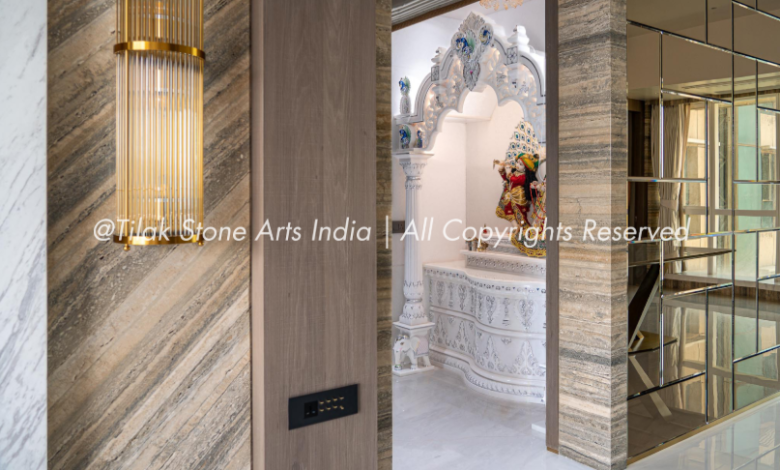Cultural Heritage in Modern Homes: Keeping Traditions Alive with Marble Pooja Rooms

The resurgence of traditional pooja spaces in contemporary homes reflects a deeper yearning for cultural connection. Modern homeowners are rediscovering the significance of dedicated prayer areas, blending ancestral wisdom with current design sensibilities. This revival isn’t merely about aesthetics but represents a conscious effort to preserve spiritual practices within rapidly evolving living environments.
Marble pooja room designs have become the cornerstone of this cultural renaissance, offering timeless elegance that transcends fleeting trends. The inherent qualities of marble—its purity, durability, and natural beauty—make it particularly suited for sacred spaces. When you incorporate marble into your prayer room, you’re choosing a material that has graced India’s most revered temples for centuries, bringing that same divine atmosphere into your home.
The Return to Sacred Domestic Spaces
Generational Wisdom in Contemporary Settings: Today’s families are increasingly recognising the value of maintaining spiritual anchors within their homes. Parents wish to pass down traditions to children growing up in a globalised world, and a dedicated pooja space serves as a tangible connection to heritage. The act of designing and installing a marble temple becomes a family investment in cultural continuity, creating a focal point for daily rituals and festive celebrations alike.
Architectural Shifts Favouring Tradition: Modern floor plans, once dominated by open-concept living, are now deliberately incorporating designated prayer areas. Architects and interior designers report growing requests for vastu-compliant pooja rooms, often positioned in the northeast corner of homes. This shift indicates that homeowners aren’t simply accommodating tradition as an afterthought but are planning their entire living spaces around these sacred zones from the initial design phase.
Material Permanence and Spiritual Symbolism: Marble’s durability mirrors the enduring nature of faith and tradition. Unlike temporary arrangements or makeshift prayer corners, a properly crafted marble temple represents commitment to spiritual practice. The cool, smooth surface of Vietnam White Marble carries associations with purity and transcendence, qualities that align perfectly with the purpose of a pooja room. When selecting materials for sacred spaces, you’re making a statement about the permanence of your spiritual values.
See also: Dressing with Intention: How Clothing Shapes Our Everyday Life
Bridging Centuries Through Stone
Temple Architecture in Miniature: The design principles governing India’s ancient temples have found new expression in residential pooja rooms. Intricate carvings that once adorned temple pillars now grace home altars, scaled appropriately for domestic spaces. Vietnam White Marble, with its fine grain and exceptional carving potential, allows craftsmen to recreate traditional motifs—lotus flowers, deity figures, and geometric patterns—with remarkable precision and detail that honours centuries-old artistic traditions.
Regional Styles Adapted for Modern Homes: Different regions of India developed distinct temple architecture styles, from the soaring shikharas of North Indian temples to the stepped pyramids of South Indian gopurams. Contemporary pooja room designs draw inspiration from these varied traditions, adapting them to suit modern spatial constraints. You might incorporate jaali work inspired by Rajasthani havelis or pillar designs reminiscent of Dravidian temples, creating a personalised sacred space that reflects your cultural roots.
Craftsmanship as Living Heritage: The techniques used to carve marble temples today remain remarkably similar to those employed by master craftsmen generations ago. Specialised designers trained in both traditional artistry and contemporary aesthetics bring a unique perspective to this work. They understand the spiritual significance of every curve and symbol whilst possessing the technical expertise to integrate these elements into modern interiors, ensuring that ancient craft traditions continue to evolve rather than becoming museum relics.
Design Fusion: Where Tradition Meets Modernity
Minimalist Frameworks with Ornate Details: One of the most successful contemporary approaches involves pairing clean, minimalist architectural elements with richly detailed traditional carvings. Perhaps you’ve noticed how a sleek, unadorned marble frame can actually enhance the visual impact of intricate deity sculptures or ornamental work. This contrast creates visual interest without overwhelming the space, allowing both modern and traditional elements to shine in their own right.
Lighting Technology Enhancing Sacred Atmosphere: Modern lighting solutions have transformed how we experience pooja spaces. Concealed LED strips can highlight the natural translucence of certain marble varieties, whilst adjustable spotlights draw attention to specific carved details during different times of day. The interplay between natural marble textures and carefully planned illumination creates an ambience that feels both ancient and thoroughly contemporary, elevating the entire spiritual experience.
Material Combinations for Contemporary Appeal: Whilst marble remains the primary material for temple structures, thoughtful integration of complementary elements can create stunning visual effects:
- Vietnam White Marble serves as the foundational material, providing purity and elegance.
- Wonder White Marble adds subtle veining patterns that introduce organic movement.
- Onyx stone elements can be incorporated selectively for dramatic translucent panels.
- Italian marble varieties might feature in surrounding flooring or wall cladding for pooja rooms.
- Metallic accents in brass or copper complement marble’s cool tones beautifully.
Open Yet Defined Sacred Zones: Modern homes often feature open floor plans, and designers have developed clever ways to demarcate pooja spaces without creating hard barriers. Raised marble platforms, decorative jali screens, or strategically positioned columns define the sacred area whilst maintaining visual connectivity with surrounding spaces. This approach respects both the need for a distinct prayer zone and the contemporary preference for flowing, interconnected living areas.
The Enduring Relevance of Heritage Design
Emotional Anchoring in Fast-Paced Lives: In an era of constant change and digital distraction, a marble pooja room offers a sense of permanence and grounding to offer daily prayers. The physical act of approaching a beautifully crafted sacred space, feeling the cool marble beneath your feet, creates a sensory transition from the chaos of daily life to contemplative stillness. This tangible, unchanging presence becomes increasingly valuable as other aspects of life accelerate and shift.
Investment in Timeless Value: Trends in interior design come and go with remarkable speed, but marble temples possess an enduring quality that transcends fashion cycles. The substantial initial investment in quality marble and expert craftsmanship pays dividends over decades, as these installations require minimal maintenance whilst retaining their beauty. You’re not simply purchasing a design element but acquiring a piece that will serve multiple generations of your family.
Cultural Identity in Global Contexts: For families living abroad or in cosmopolitan urban centres, a traditional pooja room serves as a powerful assertion of cultural identity. It becomes a teaching tool for children, a comfort for elders, and a bridge between the heritage you carry and the contemporary world you inhabit. The visual and tactile presence of marble carved with traditional motifs creates daily reminders of where you come from, even as you move forward.
Conclusion
The revival of marble pooja rooms in modern homes represents far more than an interior design trend—it signals a meaningful reconnection with cultural roots and spiritual practices. By thoughtfully integrating traditional temple design principles with contemporary architectural sensibilities, today’s homeowners are creating sacred spaces that honour the past whilst embracing the present.
The natural beauty and permanence of marble, particularly when crafted by skilled artisans who understand both material properties and spiritual significance, ensures that these installations will continue inspiring reverence for generations. If you’re considering adding a pooja room to your home, explore designs that speak to your heritage whilst complementing your modern lifestyle, creating a space where tradition and innovation coexist harmoniously.




